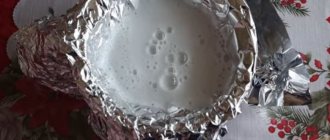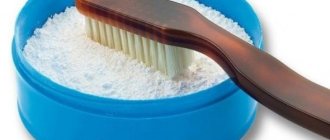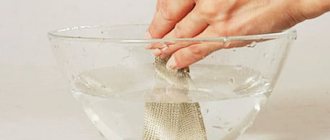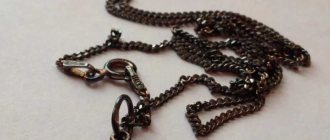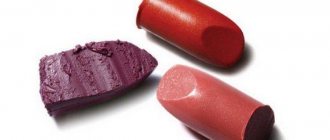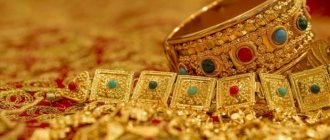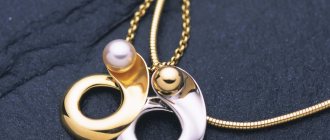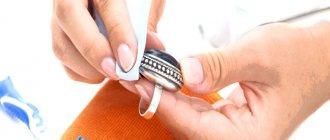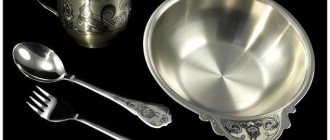Silver is a beautiful noble metal from which jewelry, coins, home decoration and dishes are made. And although silver items are counterfeited less often than gold items, sometimes it becomes necessary to verify the authenticity of the metal. How to test silver at home, read our article.
Pure silver has a silvery-white metallic hue and is highly reflective. However, if it is not cleaned for a long time, it darkens and becomes dull.
Sample and stamp
In order to check the authenticity of silver, first of all inspect the product for the presence of hallmarks and hallmarks.
The mark may look arbitrary, and sometimes be completely absent from the product. As for fineness, silver items sold on the international market must have a marked hallmark indicating the fineness of the metal. The most common numbers are 800, 830, 875, 925, 960; pure silver – 999 standard.
Do not be upset if you cannot find marks on the product - this does not mean that this is a different metal. Such a product may simply not be certified or produced in a country where the mark is not required.
The numbers on the marking indicate the percentage of silver in the alloy. For example, the 925 stamp indicates that the alloy contains 92.5% silver, and the 900 stamp indicates 90% silver content
There are other ways to test your silver. Let's take a closer look at them.
Methods for checking the quality and authenticity of silver at home
I’m willing to bet that in every home there will be not only an unidentified thing - an antique spoon or a candlestick that you want to recognize, but also the means to carry out the test immediately after reading the article, without leaving home.
Before carrying out tests, it is worth considering that there are fakes coated with a thin layer of noble metal. For accuracy, it is better to scratch the product a little to remove the top layer and conduct more than just a superficial analysis.
Sample and stamp
Products made from precious metals have been branded for a very long time. On an object, if it is made of a noble alloy, there will definitely be a corresponding stamp with a hallmark. The mark must be executed with high quality, legibly and clearly. But with the current level of technology, a sample can also turn out to be a fake.
Magnet
Silver and copper, which is usually used as the alloying component of the alloy, are diamagnetic. When such products are exposed to a magnet, they will not be attracted to it. To find out if the silver in front of you is real, simply hold it up to a magnet. If the item being tested is magnetic, it means there is no precious metal there.
Thermal conductivity
Silver holds the record among other metals for thermal conductivity. It can heat up and cool down almost instantly. This property allows you to check the metal for authenticity. Take the thing you are testing and, for comparison, put another metal object, for example a tablespoon, in hot water for a moment, take it out and touch it. The silver will have time to heat up, but the spoon will not.
You can, on the contrary, cool the objects and then pick them up. The noble alloy will immediately become warm.
Voice test
This method is good for determining the authenticity of coins. If you tap a silver coin with a metal object, the sound will be clear and clear. If the sound is dull, then the coin, alas, is ordinary. For this type of test, it is advisable to have a genuine item for comparison.
lapis pencil
The next test method is to apply a lapis pencil to the product. It can be bought at any pharmacy. To test silver, simply moisten a pencil in water and run it across the metal.
The active ingredient in the pencil is silver nitrate. There should be no traces left on the noble alloy.
Sulfuric ointment
Sulfur ointment will help identify a fake: apply a small amount of the substance to the silver and leave for an hour. If at this point the metal changes color and becomes dark, then it is genuine.
You can remove the resulting plaque using ammonia or boiling in a soda solution.
Iodine and chalk
When it comes into contact with iodine, a dark stain appears on the silver. It is almost impossible to get rid of it completely, so this method is applicable for ingots or products that are not a pity. Starch applied to the remaining trace will help to partially neutralize the effect of iodine.
When chalk comes into contact with genuine silver, it will itself acquire a grayish tint, while the metal will only become lighter. By the way, in the old days chalk was used to clean family silver from plaque.
Bleach
When in contact with chlorine, the noble metal will darken. Therefore, try not to conduct such experiments with a chain or earrings, but the inside of the ring can be carefully treated with a small drop of the product.
Vinegar
To test silver, use regular table vinegar. The liquid will not have any effect on the genuine metal, but the counterfeit will be covered with a white coating. To check, just place the item in liquid for a while.
Nitric acid
This testing method gives the most accurate result, but it is also advisable to choose a place where the remaining stain will be least noticeable. Carefully apply a little acid to the item.
The result obtained will allow you not only to check the silver, but also to understand what kind of alloy is in front of you: a brass or cupronickel silver object will become greenish, low-grade silver will darken, and samples of 925 sample and higher will become creamy at the site of exposure.
Physical impact
You can distinguish between fake and genuine jewelry without the use of chemicals. Counterfeits usually contain zinc impurities. If you turn such a thing in your hands for several minutes, a dirty residue will remain on your fingers. Pure silver will not leave any traces during such a test.
You can also check using a sewing needle. Run the tip across the metal surface without pressing. If it is a silver-plated fake, then the top layer is deformed. If the product is solid, then there will be no scratches.
Magnet
Silver, like gold, is diamagnetic, so you can quickly check its authenticity using a magnet.
Bring a magnet to the item - if it is magnetic, it means that it is either a silver-plated item or made of another metal. If the item is not magnetic, there is a very high chance that it is real silver.
Testing with a magnet may not give the desired result if the main alloy material is copper. So, cupronickel and brass (copper alloys) will not be attracted to a magnet
White paper
Take a blank sheet of paper. Run a corner over it. Silver will leave a mark, like a simple pencil, but a fake will not.
Metal detector with discrimination function
A metal detector - a device with a metal discriminator - will help you determine whether it is silver or not. This is a special function for determining the composition of metal objects. Swipe the sensor a short distance and then read the text on the monitor.
Gold chloride solution – Au2Cl6
This is a very expensive chemical. It is used by jewelers and customs officers. Checking the authenticity of items without hallmarks (for example, coins) will reveal not only Ag, but also other materials.
| Interaction time, sec. | Color | Predominant metal |
| 1 | dark green | silver |
| 2 | yellow | Al |
| 30 | black | tin |
| 40 | does not change | platinum, gold |
| 1-2 | inky black | brass, copper |
| 300 | chestnut | Au-Ag alloy |
A low-grade alloy with copper will turn black, while a high-grade alloy will give a dirty gray tint with a greenish tint.
Thermal conductivity
Silver has the highest thermal conductivity among metals - it heats up quickly and gives off heat just as quickly. Try temperature tests with the product.
If you have a coin or bar in your hands that needs to be checked for authenticity, use ice
Take an ice cube, place it on the product and observe carefully. If the ice melts quickly, as if it were placed on something very warm, you have silver in front of you. This test is suitable for flat items; it does not work well on small jewelry.
You can check a small piece of jewelry by simply picking it up - after a few seconds, the silver item will reach the temperature of your body. If you immerse a silver object in hot water for a moment, it will heat up to the temperature of the liquid in a matter of seconds.
Remember that silver darkens due to high temperature exposure, and in order to return it to its original appearance, you will have to clean the product
Appearance Features
Cupronickel, unlike silver, is not a pure metal, but an alloy of copper and nickel. Usually it also contains a small amount of iron and manganese (up to 2% in total). Due to the change in the properties of the mixture as a result of combining the components, cupronickel externally does not resemble either nickel or copper. It really resembles silver because it has the following characteristics:
- characteristic “silver” color;
- metallic shine;
- attractive appearance - the similarity with products made of precious metal is obvious.
Cupronickel spoons, forks, dishes and other items really resemble silverware. Therefore, it is very difficult to determine their differences purely by external signs. Accordingly, other methods should be used to perform reliable tests.
Voice test
This test is suitable for checking coins. When tapped, silver makes a ringing sound (especially if it is tapped with another metal). If you already have a proven silver coin, its ringing can be taken as a standard.
Gently tap the silver item (you can use another coin for this): if when you tap you hear a beautiful, open ringing, then this is real silver. If the sound is dull, it means there is little or no silver in the alloy.
A silver service can become a family heirloom and be inherited from generation to generation
lapis pencil
You can buy a lapis pencil at a pharmacy. It is often used for testing precious metals at home.
Wet the product and make a mark on it with a lapis pencil: if the metal changes color, then this is a sign of a fake. Since lapis consists of silver nitrate, it does not react in any way with either silver or gold.
Lapis pencil is a somewhat outdated remedy, and you can’t buy it at every pharmacy.
How to check the authenticity of a silver coin
Here are a few more ways to check whether the product in front of you is genuine or not. If a ring, bracelet or coin is suspicious, use one of these methods using household, improvised means:
- Rub the coin with chalk. If dark marks remain on it, the metal is real.
- Apply bleach to the surface. This substance is an oxidizing agent and the noble metal reacts to such exposure by darkening. The main thing is not to forget to protect your hands with gloves.
- Use sulfur ointment. If you apply a small amount of this composition to a coin, lightly rubbed with fine sandpaper, and wipe it with a napkin after 10–15 minutes, stains will appear on it. If they are not there, you see nickel or stainless steel in front of you, and possibly cupronickel.
- Draw a lapis pencil over the moistened product. If the coin is silver, it will be “decorated” with traces of black. A fake will not change the appearance and color.
- Apply some nitric acid to the surface. If green foam forms, this indicates a fake. When there is no foam, this does not mean that what you have in front of you is the original. Sprinkle salt on the acid and if the coin appears milky white, it is silver.
- Nitric acid is also used in “tandem” with potassium bichromate, combined in equal proportions. When it comes into contact with metal that contains more than a third of silver, this composition leaves traces of a brown-red color.
Sulfuric ointment
You can check the authenticity of silver at home using sulfur ointment (sold in pharmacies).
Apply the ointment to a small area of the product and wait 2 hours. Remove it from the surface with a dry cloth and carefully inspect the treated area: if the surface has darkened, this is silver; if it has acquired a different shade or remains unchanged, the product is made of a different metal.
The test with sulfur ointment is also carried out in another way: a small area of the product is rubbed with fine-grained sandpaper and lubricated with sulfur ointment. After 15 minutes, the result is assessed. If there is a dark spot left on the treated area, then there is a high probability that this is real silver. Metals such as nickel or stainless steel will not interact with sulfur ointment, and, accordingly, no stains will remain on the product.
To remove dark spots left after sulfur ointment, you can wipe the product with ammonia or put it in a soda solution.
Professional Silver Testing Methods
The most reliable way to understand whether silver is at your disposal or not is to contact a specialist. Home express diagnostics can lead not only to damage to the product, but also to household injuries. For example, when handling chemicals carelessly. Some people try to determine if the silver is real by looking at the tooth. Under no circumstances should you do this.
Any silver jewelry will be checked for authenticity in pawn shops, purchase shops, and jewelry workshops. Moreover, some companies provide this service free of charge. To do this, professional appraisers have special precious metal analyzers, reagents, touchstones and other tools.
That is, there is no point in checking it yourself, risking the integrity of the product.
Iodine and chalk
You can test silver with iodine.
In order not to spoil the product, carefully apply a small drop of iodine to the inner surface of the metal - a dark stain will remain on real silver. You can remove traces of iodine after testing in the following way: place the product in a bowl with grated potatoes or sprinkle with starch - under the influence of starch, traces of iodine will change their color and acquire an imperceptible bluish tint, merging with the color of silver.
Chalk not only checks, but also cleans silver. Crushed chalk is mixed with ammonia and the silver items are wiped with a soft cloth.
A similar test can be carried out using ordinary chalk. Rub the silver with a piece of chalk: a dark spot will form on the metal at the point of contact. If the blackness does not appear, you have a fake silver.
You can clean your jewelry using available products. Read how to do this in our article “How to clean silver at home.”
FAQ
Silver testing is a serious matter that should be approached responsibly. In order to avoid unpleasant situations, read in advance the questions that arise among those who test silver on their own. Please also note that jewelry not only made from silver is cleaned with a preservative. Find out how to clean gold with vinegar at home.
Have you tried checking the quality of silver yourself?
Not really
How much percent vinegar to use
For testing, only 9% table vinegar is used. Another percentage will not bring the desired result. If the acid level in the liquid is too low, the product will not react even if it is fake. And if too high a percentage is taken, it will harm the appearance of the silver item.
Which verification method is the most reliable?
None of the methods guarantees 100% results. Each of them provides information only to one degree or another. The table will help you visually see the effectiveness of checking using each method.
The effectiveness of each type of verification
| Method | Result up to 100 (in %) |
| Vinegar | 85 |
| Iodine | 87 |
| Magnet | 72 |
| Temperature check | 65 |
| Skin test | 50 |
| Chalk | 70 |
In order to achieve results, use 2 or 3 methods together.
What material material is best to use for inspection?
The material of the container into which this or that solution was poured and then the silver was placed is not so important. Metal, glass, porcelain and other containers are suitable.
How long to keep jewelry in vinegar
In order to test metal, follow the exposure rules. If 9% acetic acid is used, you will see the result in 30-40 seconds. Diluted 3% vinegar - at least 2 hours. There is no need for more, but if this happens, there is no need to worry. This will not affect the silver item in any way.
Vinegar
You can test silver with vinegar.
Pour the 9% table bite solution into a bowl and lower the product into the container for a few seconds. Since silver is a low-reactive metal, it will not react with vinegar. If a white coating appears on the product or other changes occur, this is a fake.
You can use a bite to clean silverware and dishes until they shine.
How to distinguish silver from silver plating
The easiest way is to find a brand. Silver-plated items are not branded because too little precious metal was used to make them.
If there is no mark on your item, you can carefully look at its shape and condition. If the item is silver-plated, the coating in some places may have worn off or started to fall off - look for cracks and chips. Finally, jewelry made entirely of silver does not rust. If rust is noticeable on silverware or jewelry, it means that you are looking at silver plating.
Nitric acid
You can test silver using nitric acid - this test is considered one of the most accurate.
Wear gloves and a protective mask, select an inconspicuous area on the product, lightly scratch it to remove any protective coating, and apply a drop of nitric acid. If you have a low-quality silver alloy - cupronickel or silver-plated brass - a greenish stain will remain on the product. This is due to the fact that the product contains high levels of copper. When exposed to nitric acid, silver will turn dark, while sterling silver (925) will turn creamy.
Today you can purchase a professional silver test in jewelry stores and conduct a chemical experiment at home.
Visual inspection
Inspecting the product is the first way to identify silver before purchasing. Here we will focus on two points: sample and external characteristics.
Silver sample
The test will allow you to visually distinguish silver from other metals. Silver products sold through Russian jewelry stores are subject to hallmarking. This is done by the State Assay Office.
On silver jewelry, it doesn’t matter whether it’s regular or gilded silver, the standard value is usually 925, which is called sterling silver. On Soviet silver items you can find hallmark 875 and a five-pointed star icon. And in Tsarist Russia, stamps were two-digit, so such finds are possible in antique stores.
The mark consists of three elements that are read from left to right:
· one-letter code of the State Assay Supervision Inspectorate;
· the mark of the hallmark - the head of a woman in a kokoshnik, turned in profile;
· three-digit standard of precious metal - indicates the proportion of noble metal in the alloy: for example, 925 silver contains 92.5% pure silver.
Another mandatory element of silver jewelry is the manufacturer’s mark (name). Rings are most often branded on the inside of the tavern, for chains the brand is placed on the lock, for earrings - on the earrings, for spoons - on the handle on the back side.
On foreign-made jewelry sold through Russian chains, the name tag may be absent, and the hallmark may be indicated by words. For example, the sterling marking is an analogue of the 925 standard.
Not all consumers are aware of the changes in the law. From June 23, 2020, in jewelry stores you can find Russian-made silver products without hallmarks, and this will not be a violation on the part of the seller.
Previously, mandatory testing and marking with the state hallmark was carried out only for silver products weighing over 3 g. The decision to test such a product was made by the manufacturer on a voluntary basis.
At the same time, the rule about the mandatory existence of a name tag on a silver product has been preserved.
Product quality
During a visual inspection, check that all elements are well secured. For example, if this is a ring with stones, then pay attention to the quality of the setting. The inserts should not be glued - no self-respecting jewelry company will use glue even in a budget product. In chains and chain bracelets, all links must be soldered and there must be no gaps. See if the connecting ring between the lock and the product itself is soldered.
Scratches, abrasions, stains on a new product are a reason to be wary. However, when buying secondhand, such defects are also possible on real silver, because it is a rather soft metal.
Tag
The seller is obliged to provide the buyer with reliable information about the product. Make sure that the information on the tag is written accurately and completely and reflects the real state of affairs. The sample indicated on the label must correspond to the marking of the jewelry. The tag also indicates the weight of the product in grams, and, if there are inserts, their characteristics.
Physical impact
You can check the authenticity of silver using physical impact.
Rub the product to be tested in your hands for 1-2 minutes. If you have high-quality silver in front of you, then your hands will remain clean after rubbing; if the product contains zinc impurities, barely noticeable dark spots will remain on your fingers.
Try testing your silver with a needle. If you suspect that you have a silver-plated product, lightly scratch an inconspicuous (internal) area with a needle: a thin layer of silver will easily be removed from a fake, but nothing will happen to the genuine metal.
The expert will give accurate information about the authenticity of silver and determine the content of impurities of other metals
All the methods described above will help determine the authenticity of a silver product with a certain degree of probability. To get a 100% guarantee, have your item examined by professionals: they know exactly how to test silver.
Characteristics and properties of metal
Silver (Ag) is the 47th element of the Mendeleev Periodic Table. Melting point – plus 962 oC, density – 10.5 g/cm3. Electrical resistivity – 1.59⋅10−8 Ohm m at a temperature of 20 °C.
The noble metal in its pure form reacts weakly with other substances. It is insoluble in hydrochloric and dilute sulfuric acid, soluble in mercury and ferric chloride.
Silver does not oxidize under the influence of oxygen, but when exposed to air over time it can lose its luster and darken. The fact is that it reacts with hydrogen sulfide molecules present in small quantities in the atmosphere. As a result, silver sulfide is formed. Its coating gives darkening. This is especially noticeable in conditions of high humidity.
2Ag + 2H2S + O2 = 2Ag2S + 2H2O
Halogens easily oxidize Ag to halides. Many methods for determining the authenticity of silver products are based on this.
Important: carry out all studies based on the chemical interaction of metal on a cleaned surface. Choose an inconspicuous area.
